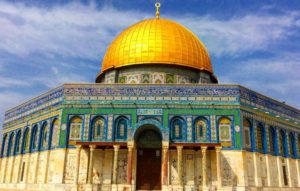Al-Aqsa Mosque/ The Night Journey
In 680, fifty years after Omar’s conquest of Jerusalem, the Damascus-based Umayyad dynasty engaged in a struggle for control of the Muslim world with a rebel dynasty based in Mecca. The Umayyads opted to fight the rebels by damaging Mecca’s economy, which was based almost entirely on revenues from Muslim pilgrims. Their secret weapon was to create a competing pilgrimage site by building a magnificent edifice, the Dome of the Rock, on the site of the destroyed Jewish temple and hoping that this mosque would weaken Mecca’s economy by siphoning off pilgrims from Mecca. Thus, a political strategy designed to fight mutineers in far-off Mecca transformed Jerusalem’s Temple Mount into a Muslim holy site with far-reaching implications to this day.
Al-Aqsa Mosque (the Furthest Mosque), the second mosque on the Temple Mount, was built in 715 and was linked to a Muslim legend, based on an ambiguous verse in the Qur’an concerning Muhammad’s night journey to heaven. In this way, the Umayyads cleverly associated Muhammad’s life with Jerusalem even though the prophet died years before the city’s capture by the Muslims. This construction further cemented the site’s holiness to Islam. Nonetheless, during this first phase of Islamic governance, Muslim rulers were generally tolerant of Jewish activities on the Temple Mount. Whenever a more intolerant ruler assumed control of the city, Jews were forbidden from praying on the Mount but instead worshipped at one of the many Temple Mount gates; an eleventh-century document found in the geniza or storeroom of Cairo synagogue describes the circuit followed the pilgrims and the prayers they recited at each of the gates.
Source: F.M. Loewenberg. Middle East Quarterly. Summer 2013, pp. 37-48.
